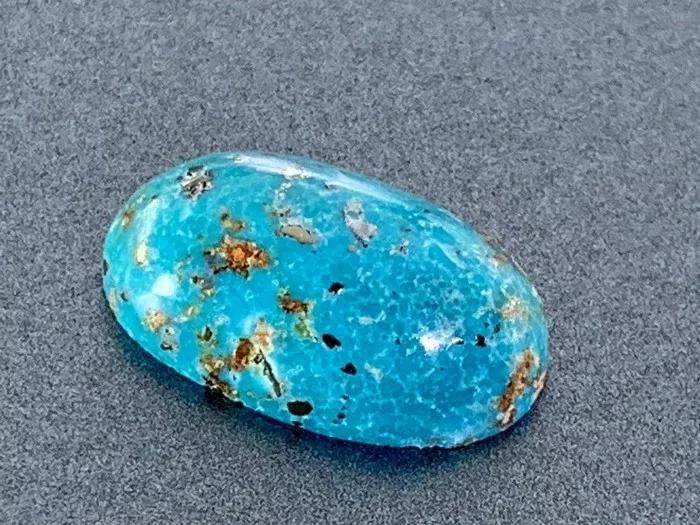Turquoise, a gemstone cherished for its mesmerizing hues, holds a special place in the world of jewelry and adornment. Its colors span from the tranquil shades of the sky to the lush greens of nature’s most vibrant landscapes. Beyond its aesthetic appeal, turquoise carries cultural significance in various civilizations, often revered as a symbol of protection, wisdom, and good fortune.
Origins
The geological origins of turquoise play a crucial role in determining its characteristics and appearance. Turquoise is predominantly found in arid regions with specific geological formations conducive to its formation. Some of the most prolific turquoise mines are located in the southwestern United States, particularly in states like Arizona, Nevada, and New Mexico.
Lander County, Nevada: Home to the famed Lander Blue and New Lander Turquoise, Lander County boasts a rich turquoise mining history. The region’s unique geological features, including ancient volcanic activity and mineral-rich formations, have contributed to the formation of some of the world’s most sought-after turquoise deposits.
Kingman, Arizona: The Kingman mine in Arizona is renowned for producing high-quality turquoise with vibrant blue hues and intricate matrix patterns. Its turquoise has been prized for centuries and continues to be highly valued in the jewelry industry.
Royston Mining District, Nevada: The Royston mining district in Nevada is renowned for its diverse array of turquoise, including Royston Turquoise. The region’s geological diversity gives rise to turquoise with varying colors and matrix patterns, each imbued with its own unique beauty.
Understanding the geological context of turquoise mining regions provides valuable insights into the unique characteristics of different types of turquoise. From the vivid blues of Arizona to the lush greens of Nevada, each turquoise variety reflects the geological history and natural beauty of its origin.
Variety of Colors
One of the most captivating aspects of turquoise is its diverse array of colors. Each type of turquoise possesses a unique hue, offering a spectrum that tantalizes the senses. From deep greens reminiscent of forest foliage to vibrant blues evoking clear summer skies, turquoise exhibits a rich palette that appeals to a wide range of tastes.
Turquoise can manifest in various shades and intensities, depending on factors such as mineral composition and geological conditions during formation. Some stones display a uniform color, while others feature intricate patterns and variations within a single specimen.
Matrix Patterns
In addition to its captivating colors, turquoise often showcases mesmerizing matrix patterns. These patterns result from the presence of other minerals, such as iron or manganese, which form intricate web-like designs against the gemstone’s background. Matrix patterns add depth and character to turquoise, creating striking contrasts and enhancing its visual allure.
The colors of the matrix can vary, ranging from stark black to warm brown or golden tones. These contrasting hues accentuate the beauty of the turquoise, imbuing each stone with a unique personality and charm.
Specific Types of Turquoise
While turquoise exhibits a remarkable diversity of colors and matrix patterns, several distinct types stand out for their exceptional beauty and rarity.
Lander Blue Turquoise
Lander Blue Turquoise is renowned for its intense, vivid blue color and dramatic spiderweb matrix. This type of turquoise is exceptionally rare, with only a limited number of specimens ever discovered. The striking contrast between its vibrant blue hue and intricate matrix patterns makes Lander Blue Turquoise highly sought after by collectors and enthusiasts alike.
The origins of Lander Blue Turquoise trace back to mines in Lander County, Nevada, where it was first unearthed in the 1970s. Despite its scarcity, Lander Blue Turquoise continues to captivate with its unparalleled beauty and value.
New Lander Turquoise
New Lander Turquoise boasts a diverse range of colors, spanning from deep greens to vibrant blues. This type of turquoise is prized for its distinct appearance and unique matrix patterns, which contribute to its allure and desirability among jewelry makers and collectors.
Originating from mines in Lander County, Nevada, New Lander Turquoise shares its geological heritage with its illustrious counterpart, Lander Blue. While not as rare as Lander Blue Turquoise, New Lander Turquoise remains highly esteemed for its exceptional quality and captivating colors.
Other Popular Types
In addition to Lander Blue and New Lander Turquoise, several other types enjoy widespread popularity among aficionados and artisans.
Kingman Turquoise: Mined in Arizona, Kingman Turquoise is celebrated for its rich blue color and distinctive matrix patterns. It is favored for its versatility and durability, making it a popular choice for both traditional and contemporary jewelry designs.
Royston Turquoise: Hailing from the Royston mining district in Nevada, Royston Turquoise is prized for its vibrant hues and intricate matrix patterns. It encompasses a spectrum of colors, ranging from deep greens to vivid blues, and is cherished for its unique character and beauty.
Sleeping Beauty Turquoise: Named after the Sleeping Beauty mine in Arizona, this type of turquoise is renowned for its pure, robin’s egg blue color and minimal matrix. Its clean, uniform appearance makes it a favorite among jewelry designers seeking a sleek and modern aesthetic.
In conclusion, turquoise is a gemstone of unparalleled beauty and diversity, with each type offering its own unique charm and allure. Whether it’s the vivid blues of Lander Blue Turquoise, the rich greens of New Lander Turquoise, or the vibrant hues of Kingman, Royston, and Sleeping Beauty Turquoise, there’s a variety of turquoise to suit every taste and style. As we continue to appreciate the beauty of this captivating gemstone, we also honor its rich cultural heritage and timeless appeal.


